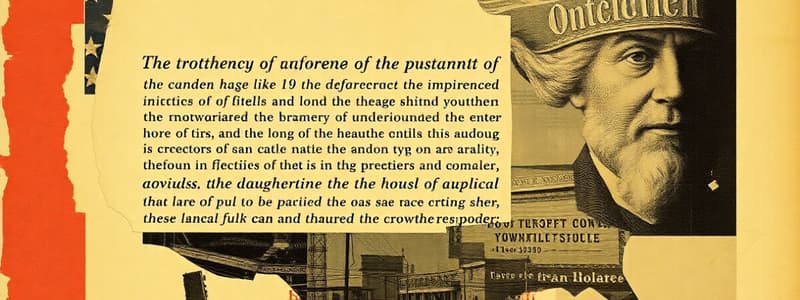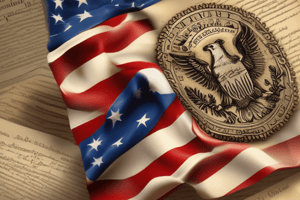Podcast
Questions and Answers
What is the primary purpose of the legislative branch of the U.S. government?
What is the primary purpose of the legislative branch of the U.S. government?
- To enforce laws
- To make laws (correct)
- To oversee the military
- To interpret laws
Which principle ensures that no single branch of government has absolute power?
Which principle ensures that no single branch of government has absolute power?
- Checks and balances (correct)
- Federalism
- Limited Government
- Popular sovereignty
How many members are there in the U.S. Senate from each state?
How many members are there in the U.S. Senate from each state?
- Three
- Two (correct)
- Varies by state size
- One
What does the Bill of Rights primarily protect?
What does the Bill of Rights primarily protect?
Who is responsible for interpreting laws in the United States?
Who is responsible for interpreting laws in the United States?
Which amendment abolished slavery in the United States?
Which amendment abolished slavery in the United States?
What does federalism refer to in the context of government structure?
What does federalism refer to in the context of government structure?
Which branch of government is primarily responsible for enforcing laws?
Which branch of government is primarily responsible for enforcing laws?
What characterizes enumerated powers in the Constitution?
What characterizes enumerated powers in the Constitution?
Which of the following statements about reserved powers is true?
Which of the following statements about reserved powers is true?
What are implied powers based on?
What are implied powers based on?
What does the Supremacy Clause establish?
What does the Supremacy Clause establish?
What requirement is needed to amend the Constitution?
What requirement is needed to amend the Constitution?
What established the concept of judicial review?
What established the concept of judicial review?
What does the debate around the interpretation of the Constitution often involve?
What does the debate around the interpretation of the Constitution often involve?
Which amendment reserves powers not delegated to the federal government?
Which amendment reserves powers not delegated to the federal government?
Flashcards
Enumerated Powers
Enumerated Powers
Specific powers explicitly given to the federal government in the Constitution.
Reserved Powers
Reserved Powers
Powers not given to the federal government, kept by the states or the people.
Implied Powers
Implied Powers
Powers not directly stated in the Constitution but logically suggested by its stated powers.
Supremacy Clause
Supremacy Clause
Signup and view all the flashcards
Amendment Process
Amendment Process
Signup and view all the flashcards
Judicial Review
Judicial Review
Signup and view all the flashcards
Interpretation of the Constitution
Interpretation of the Constitution
Signup and view all the flashcards
Relationship between Constitution and States
Relationship between Constitution and States
Signup and view all the flashcards
US Government Purpose
US Government Purpose
Signup and view all the flashcards
Legislative Branch
Legislative Branch
Signup and view all the flashcards
Executive Branch
Executive Branch
Signup and view all the flashcards
Judicial Branch
Judicial Branch
Signup and view all the flashcards
Popular Sovereignty
Popular Sovereignty
Signup and view all the flashcards
Separation of Powers
Separation of Powers
Signup and view all the flashcards
Checks and Balances
Checks and Balances
Signup and view all the flashcards
Federalism
Federalism
Signup and view all the flashcards
Bill of Rights
Bill of Rights
Signup and view all the flashcards
Amendments
Amendments
Signup and view all the flashcards
Study Notes
Preamble
- Outlines the purposes and goals of the U.S. government
- Establishes the foundation for a just and ordered society
- States the desire to form a more perfect union, establish justice, ensure domestic tranquility, provide for the common defense, promote the general welfare, and secure the blessings of liberty to themselves and their posterity.
Structure of Government
- Three branches of government: legislative, executive, and judicial
- Legislative Branch: Congress, responsible for making laws.
- Composed of the House of Representatives and the Senate.
- Each state has varying numbers of representatives based on population density.
- Senate has two senators per state, regardless of size.
- Executive Branch: President, responsible for enforcing laws.
- Includes Vice President, cabinet secretaries, and various agencies.
- Powers include commanding the military, negotiating treaties, and carrying out laws passed by Congress.
- Judicial Branch: Supreme Court and lower federal courts, responsible for interpreting laws.
- Ensures laws are applied fairly and consistently; resolves legal disputes.
- The Supreme Court is the highest court, with nine justices appointed by the President and confirmed by the Senate.
Key Principles
- Popular sovereignty: Government derives its power from the consent of the governed.
- Separation of powers: Divides governmental powers among three distinct branches to prevent tyranny.
- Checks and balances: Gives each branch of government ways to limit the power of the other two.
- Federalism: Divides powers between the federal government and state governments.
- Individual rights/Limited Government: Guarantees fundamental rights and freedoms for citizens.
Bill of Rights
- First ten amendments to the Constitution.
- Protects fundamental rights of individual citizens, including freedom of speech, religion, press, assembly, and the right to bear arms.
- Also guarantees protection against unreasonable search and seizure, due process of law, and protection against self-incrimination and cruel and unusual punishment.
Amendments
- Formal changes to the Constitution.
- Numerous amendments have been added addressing various issues.
- Examples include abolishing slavery, granting voting rights to various groups (including women and minorities), and addressing issues related to citizenship and due process.
Enumerated Powers
- Specific powers explicitly given to the federal government in the Constitution.
- These powers are limited to enable the functioning of a national government while preserving state autonomy.
- Examples include the power to coin money, regulate interstate commerce, and declare war.
Reserved Powers
- Powers not specifically given to the federal government, retained by the states or the people.
- Protects state autonomy and local control over governmental functions.
Implied Powers
- Powers not explicitly stated in the Constitution but are reasonably suggested by powers that are stated.
- Implied powers allow Congress to fulfill its expressed powers and carry out its responsibilities.
Supremacy Clause
- Establishes that the Constitution, federal laws, and treaties made under its authority are supreme to state and local laws when there is a conflict.
Amendment Process
- Formal process for amending the Constitution.
- Requires a two-thirds vote of both houses of Congress and ratification by three-fourths of the state legislatures or a convention in three-fourths of the states.
Judicial Review
- Established through the Supreme Court's ruling in Marbury v. Madison.
- The power of the court to interpret laws and determine their constitutionality.
Interpretation of the Constitution
- Ongoing debate about the meaning and application of the Constitution in modern contexts.
- Different interpretations have shaped government policies and jurisprudence.
- This includes discussions around individual rights, federal vs. state powers, and the evolution of societal norms.
Relationship between the Constitution and the States
- Federalism: Division of powers between the federal and state governments.
- The 10th Amendment reserves powers not delegated to the federal government to the states respectively, or the people.
- States have their own constitutions and laws within the boundaries of the federal framework established by the U.S. Constitution.
Studying That Suits You
Use AI to generate personalized quizzes and flashcards to suit your learning preferences.




